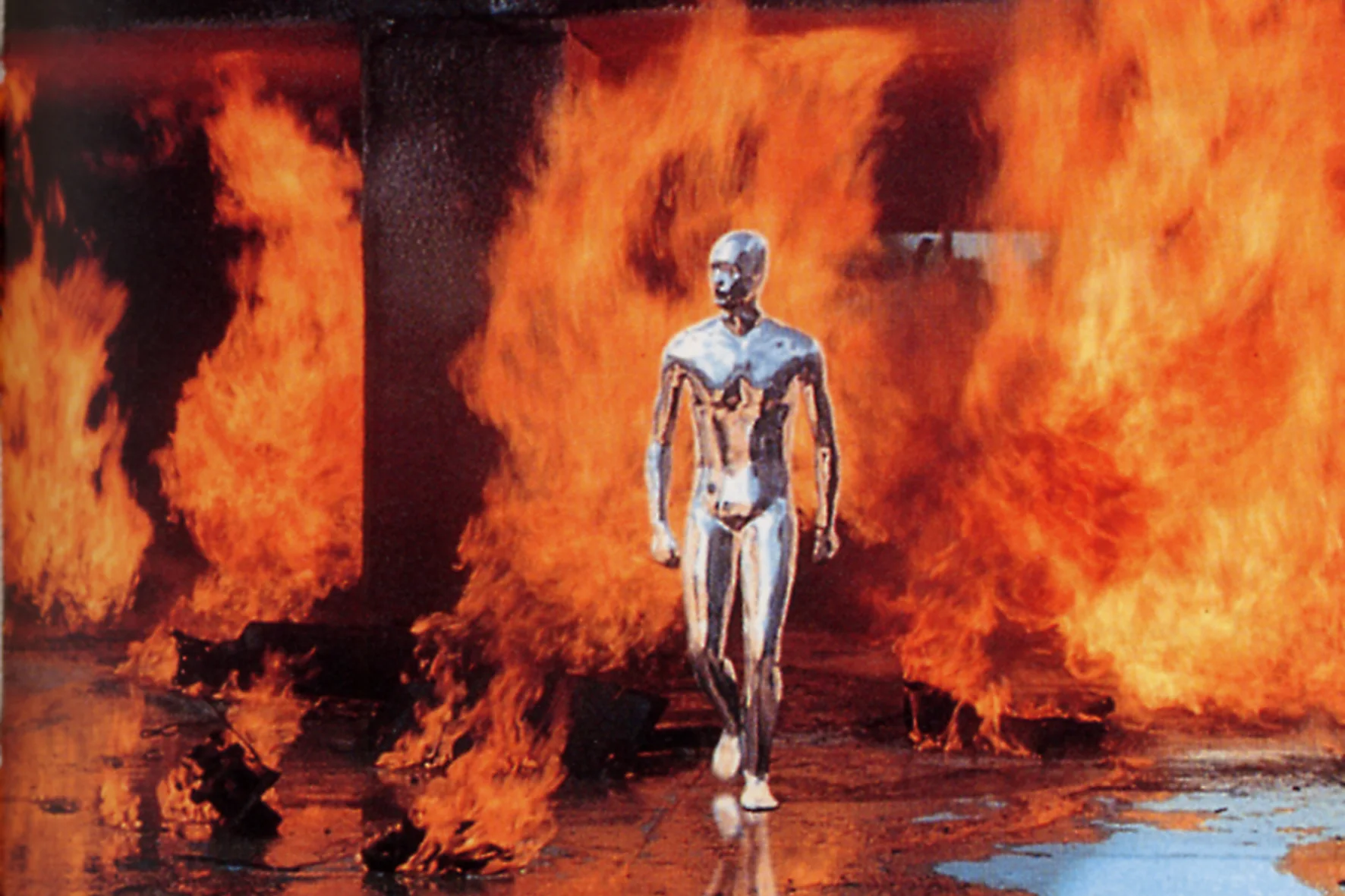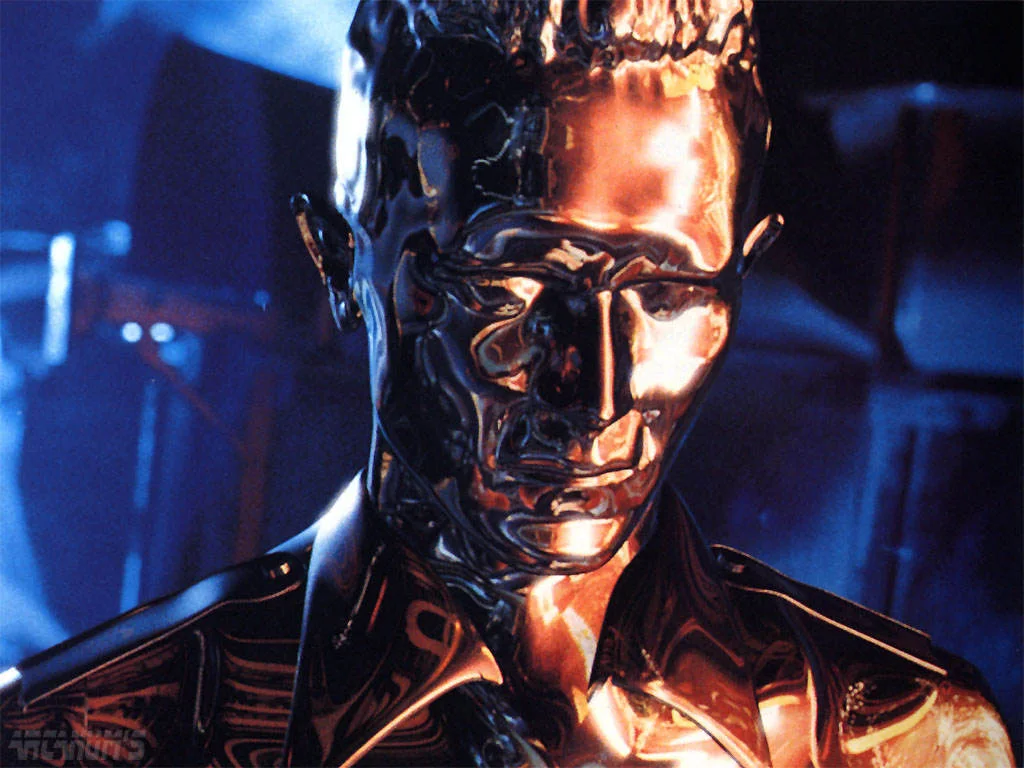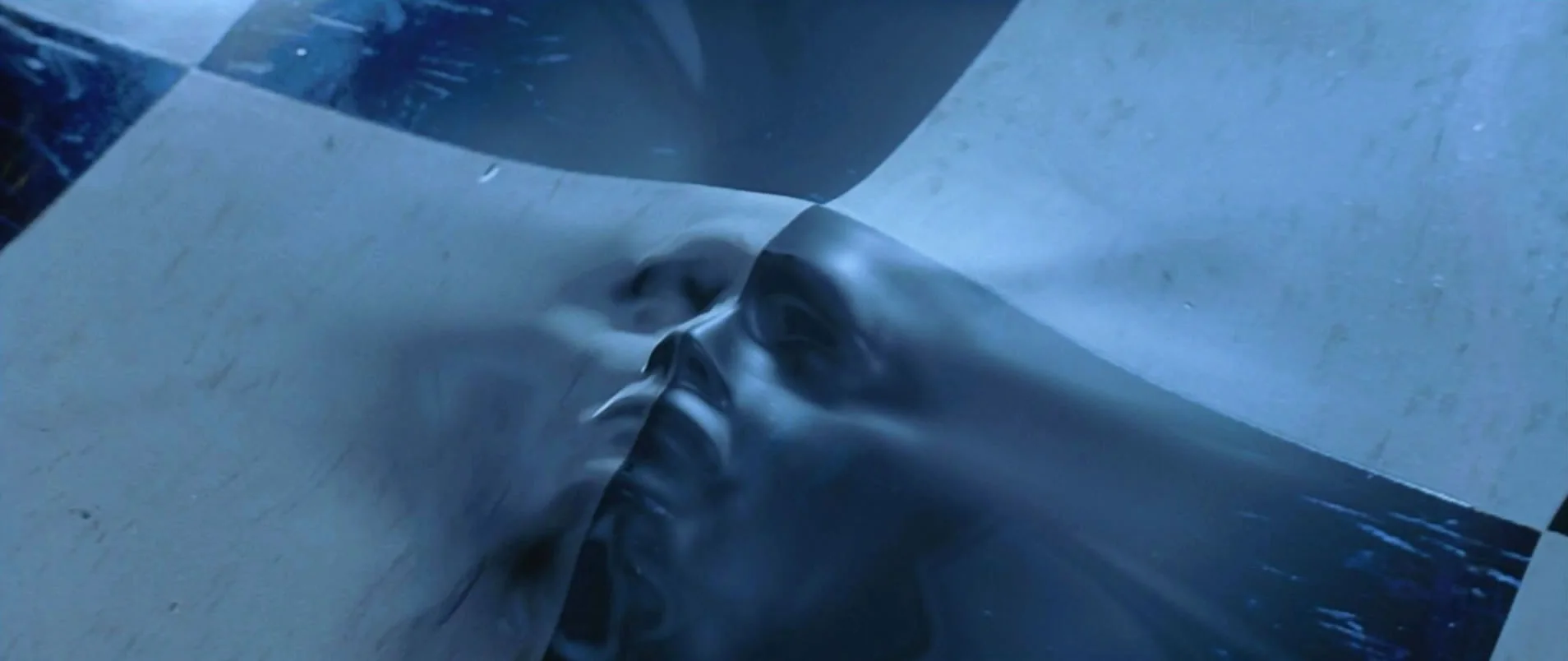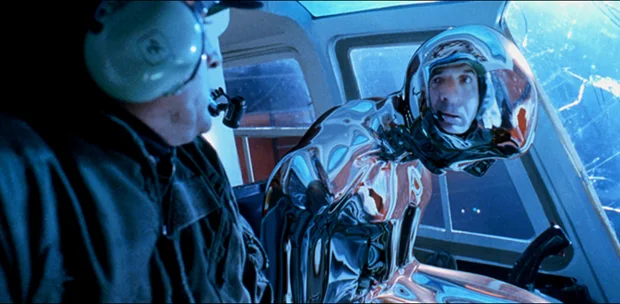We were on the edge, making up history as we went along.

Terminator 2, while being a classic action sci-fi film, has always carried with it a level of gravity, maturity, and character development, somewhat unique for its genre. However, it is through its unprecedented use of computer graphics that it becomes an incredibly significant film in cinema history. In retrospect, it can be framed as a kind of unintentional horror film, whose historical antagonist is computer graphics itself (a force that will eventually jeopardize everything in Hollywood storytelling, from narrative, meaning-making, to our basic humanity).

"There is nothing we can do that will duplicate living things, we can come close, but we can't do it exactly."
-
When viewing the behind-the-scenes making of Terminator 2 (henceforth T2), there is a consistent theme amidst the discussion. Legendary figures of visual effects like Stan Winston, himself a master of physical robotic character effects, discuss the need for visual effects to be in service of the story, the characters, and the filmmaker's vision. It is with a great irony that the most powerful vfx tool initially in service of story and character would start to, over the next decade, play a starring role in the subversion of great characters, authentic human moments, and meaningful narratives. There is a telling humility to the vfx designers of T2 as they maintain that their craft will never perfectly achieve a “perfect simulacra”, never become an identical copy of reality. They fundamentally did not expect nor demand their work to replace “the real”, instead approaching the work on its own merits, and its relation to the larger cinematic piece. This patient and exploratory mentality stands in stark contrast to the aggression of what modern VFX has become - many modern film-makers, amidst increasingly absurd or unrealistic narratives or characters, eschew this basic understanding of visual effects as they propagate ever more uncanny and photo-realistic 3D hyper-realities. At this time in film-making and history, 1990, there was still a more clear division between fantasy and reality, and an accompanying respect for preserving that division, a gravitas in using fantasy to say profound things about our shared world.
-
Its incredible to think, but at the time, it was commonly thought that computers were not going to be a big part of film-making, and were not worth investing in.

What T2 unleashed was the promise of creating anything in cinema through visual effects. CGI undoubtedly gives film-makers the ability to fulfill their wildest dreams through techniques such as modeling, texturing, scanning, manipulating, compositing, rendering anything they desire into new, constructed images --- but at what cost? Our current cinematic landscape, so over-saturated with computer generated imagery, has a stark lack of developed story and character. While the marketing engines of massive corporations can find ways to sell derivative and vapid filmic formulae as commercial successes, the art and meaning once common in larger scale films now seems perpetually threatened. Stories that have been proven to be commercially viable are beaten long after they are dead or rotting, crushed under the digital wheels of theme-park style cinema, endless in its resurrection but dead to its core, relying on the crutch of the spectacle to hypnotize audiences into believing often self-referentially vacuous tales of the apocalypse (be it at the hands of aliens, robots, wizards, super-villains, or a plethora of others beings, themselves not even full characters, but merely excuses, high-definition hosts, for swirling particle systems and dazzling digital effects).
-
Indeed, in contemporary big-budget cinema, it seems the world is always ending, perpetually consumed by some digital monster. This monstrous lineage was born when Terminator 2 was released, and its DNA was forged when ILM created the T-1000.
below : behind the scenes of Captain America : Civil War a common big-budget movie set now where much of the world, and many of the characters, are either created entirely in the computer or significantly modified with the use of CGI.

The T-1000 burst into Hollywood as an iconic movie villain. “He” is stoic, with little personality, a killing machine from the future who can appropriate the visage of any character or object within the film. While the T-1000 functioned as a thoughtfully conceived character and narrative device in T2, the VFX breakthroughs used to create him now amplify his meta-villainy, as a modern antagonist in the history of film culture.
-
Many of the aesthetic and ethical conundrums faced by contemporary digital film-makers harken back to the T-1000. Situations like the resurrection of dead actors (as audiences saw with Peter Cushing's essentially unauthorized and certainly uncanny return in “Star Wars : Rogue One”), grew from the achievements of T2 but also reflect its methodologies within the context of the T2 narrative. The T-1000 routinely employs a mirror tactic to get past human defenses; in his perhaps more brutal method, he murders a character before assuming its identity. But just as the T-1000 seeks to gain advantage through deceitful imitation, so too did the resurrection of Cushing attempt to foil filmic limitation via virtuosic mimicry. Once the human was made digital (and the path towards convincing simulation was revealed), the stage was set for an unsure future, where the Real is thrown into doubt, and where the digital begins to colonize the Real, overriding existing systems of authority and narrative.
-

This idea of the shapeshifting Other that murders and replaces the individual permeates paranoid science fiction works of the past, other classics like Invasion of the Body Snatchers or The Thing; however, it is particularly unique in T2 because of the specific nature of the murder. The digital creation is literally murdering the Real and taking its place. The coincidence of this technical achievement, and its unintentional act of terrorism against consensus reality, is an incredible moment in film history. It is the beginning of the shift from analog to digital, in an era where most thought that CG would not be a particularly useful tool ( imagine that ! ). This palpable breakthrough is part of T2’s success, and one of the reasons it is subconsciously emulated ad infinitum in culture, while rarely recreating the initial achievement or relevance.
-
the technological advancements in the intervening years (or perhaps in part because of them), Terminator Genisys falls victim to the plight of other contemporary works attempting to recreate T2’s successful approach to VFX. Watching a simulacra of a simulacra (i.e. the T-1000 returning in the guise of a different actor chasing after newly groomed stand-ins or digital doubles) feels inevitably ineffectual, absurd, and lacking weight or consequence. It is as if the villain we loved in 1990 has now truly done its work; it has vanquished our heroes and murdered the past, replacing it with a cold digital double.
-
The viewer is left grappling with this unsatisfying digital reproduction, in what has become an unfortunately familiar malaise for modern audiences. As beloved narratives are constantly dismantled and re-simulated in our era, something important is sacrificed in the march towards an unending cinematic apocalypse, forever wielding its sole product: predictable box-office results.
-

-
The T-1000 has a lot to say about our world and history. In a time when we are often fooled by digital stand-ins for accurate information (Facebook feeds, micro-climates of reinforced false information, “fake news,” whatever it may be), the T-1000 shows us a nuanced image of the digital: something that, while astounding and thrilling, can also destroy the past, and make us doubt the reality of any situation. Within this character is the makings of a great many contemporary dystopian nightmares and realities.
-
"Who controls the past controls the future; who controls the present controls the past." - George Orwell
-
Indeed, this is the very goal of the killing machine in the context of the T2 narrative --- it comes into the present from the future, seeking to destroy the past and reshape human history through disrupting the most personal human interrelationships. It takes aim at the sacredly human, bent on eroding the lineage of humanity from its surface through to its foundation. In attempting to do so, it throws into doubt the Real of the present, thrilling and hypnotizing as it enacts its mission. Even the characters whose lives are threatened by the T-1000 inevitably succumb to its uncanny surreality, unable to look away as they are murdered. It is by this very mechanism that computer graphics took control of Hollywood's cinematic narratives, which in turn begin to shape many of our life narratives, continuing to propagate in the cultural zeitgeist long after the final frame rolls.
-
_____

One of the most terrifying aspects of the T-1000 is not only his shapeshifting and assuming of identity, something we have become very familiar in the digital age (in which governments, hackers, scam artists, can all assume alternate identities much more readily through employing digital camouflage), is his ability to circumvent symbols and systems of authority. The T-1000 both subsumes the image of authority to employ for his benefit ( as if the case with his use of the default policeman uniform to achieve a culturally accepted authority ), and uses his physical reconstitution to move past established authoritarian barriers like locked gates, closed elevator doors, or windshields of cars and helicopters.
-
both imitating perceived authority to circumvent it, and by reprogramming his physical apparatus to hack or move between the seams of established borders, he represents the digital stack's ability to override all previous power structures and wreak havoc in modern life. The T-1000 is at once a symbol of digital invasion, the impotence of pre-digital authority, as well as a kind of stand-in for the surveillance state that we know to employ these same tactics to track and pursue any individuals it perceives as threatening to its monopoly on structural violence.
-
While it is tempting to make the symbol of the T-1000 safely the result of a descent into big budget distraction --- it also can be seen as a far more serious omen and symbol for the downsides to increasing virtualization in all aspects of life.

The filmmakers and technicians behind this villain found themselves as the conduit for a classic blockbuster, not because they sat comfortably in narrative and aesthetics that had been accomplished, resurrecting rehashed concepts pumped with ever greater spectacle. Instead, they transcended the limitations of the day, and made a narrative about this very transcendence, both its horror and its majesty. This was the real magic trick, it was as much a narrative one as it was a technical achievement. It was the invocation of a narrative surrounding the potentially apocalyptic side-effects of our technological lust, one which could not have been possible without the technological march it warned against. It is a paradox, and like all great art, its roots are within us, not the tools used to invoke it.
-
In this context, the T-1000 becomes more than just a CGI killing machine, it is also a mirror image of humanity when we have given our souls over to a glossy surface without substance. It is a warning about the photoshopped image, the perfected human form, the CG avatar. It shows us the dehumanized villain we can become when we have lost the original, and when we become the mirror copy --- left with only with the ability to replicate, unable to create or innovate. In a sense, this is the true horror of the T-1000, and a lesson for film-makers as we move forward in the digital age.
-
___

The filmmakers and technicians behind this villain found themselves as the conduit for a classic blockbuster, not because they sat comfortably in narrative and aesthetics that had been accomplished, resurrecting rehashed concepts pumped with ever greater spectacle. Instead, they transcended the limitations of the day, and made a narrative about this very transcendence, both its horror and its majesty. This was the real magic trick, it was as much a narrative one as it was a technical achievement. It was the invocation of a narrative surrounding the potentially apocalyptic side-effects of our technological lust, one which could not have been possible without the technological march it warned against. It is a paradox, and like all great art, its roots are within us, not the tools used to invoke it.
-
In this context, the T-1000 becomes more than just a CGI killing machine, it is also a mirror image of humanity when we have given our souls over to a glossy surface without substance. It is a warning about the photoshopped image, the perfected human form, the CG avatar. It shows us the dehumanized villain we can become when we have lost the original, and when we become the mirror copy --- left with only with the ability to replicate, unable to create or innovate. In a sense, this is the true horror of the T-1000, and a lesson for film-makers as we move forward in the digital age.
-
___
relevant to this article :
Rogue One : Bringing Peter Cushing back to life
The Making of T2